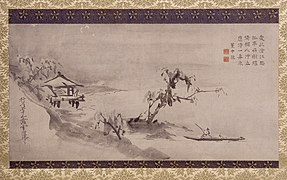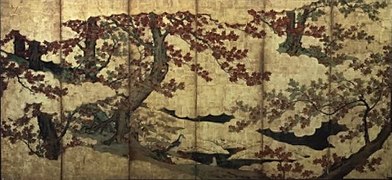Yamaguchi Sekkei
Yamaguchi Sekkei ( Japanese 山口 雪 渓 , actually Yamaguchi Sōsetsu ( 山口 宗 雪 ), other stage names ( Gō ): Baian ( 梅 庵 ), Hakuin ( 白 隠 ); born 1644 ; died October 22, 1732 ) was a Japanese painter during the middle Edo period .
life and work
Although 1644 is the generally accepted year of Sekkei's birth, the work that deals with the “Buddha's entrance into paradise” ( 涅槃 図 , Nehan-zu ) and which is located in Kiyomizu-dera in Kyōto gives his year of birth as 1649 .
It is said that Sekkei was such a great admirer of the painters Muqi ( Chinese 牧 谿 , Pinyin Mùqī , Japanese Mokkei ; 2nd half of the 13th century) and Sesshū ( 雪 舟 ) that he created his stage name from one character of each of these names . It is also said that he studied under Kanō Einō .
Yamaguchi did not paint in the style of his time, but sought his way in the traditional and created his own style. His best-known works are the "Autumn Maple" screen pair in Daigo-ji in Kyōto and the wall paintings ( 障 壁画 , Shōheki-ga ) in Shumpo-in ( 春 浦 院 ), a sub-temple of Myōshin-ji that is not open to the public , also in Kyoto. These are located there in the abbey residence and include 15 pictures with people in the landscape ( 山水 人物 図 , Sansui jimbutsu-zu ), 16 pictures with the theme of flowers and birds ( 花鳥 図 , Kachō-zu ) and 12 pictures with the mountain saints ( 群仙 図 , Gunzen-zu ).
photos
Remarks
- ↑ The 渓 kei in Sekkei's name is a variant of 谿 qī / kei .
- ↑ This pair of screens was shown in 1939 at the exhibition of Old Japanese Art in Berlin. The couple is registered as an Important Cultural Property of Japan .
Web links
literature
- Tazawa, Yutaka: Yamaguchi Sekkei . In: Biographical Dictionary of Japanese Art. Kodansha International, 1981. ISBN 0-87011-488-3 .
- Laurance P. Roberts: Sekkei . In: A Dictionary of Japanese Artists. Weatherhill, 1976. ISBN 0-8348-0113-2 .
| personal data | |
|---|---|
| SURNAME | Yamaguchi, Sekkei |
| ALTERNATIVE NAMES | 山口 雪 渓 (Japanese); Yamaguchi Sōsetsu (real name); 山口 宗 雪 (real name, Japanese) |
| BRIEF DESCRIPTION | Japanese painter |
| DATE OF BIRTH | 1644 |
| DATE OF DEATH | October 22, 1732 |


